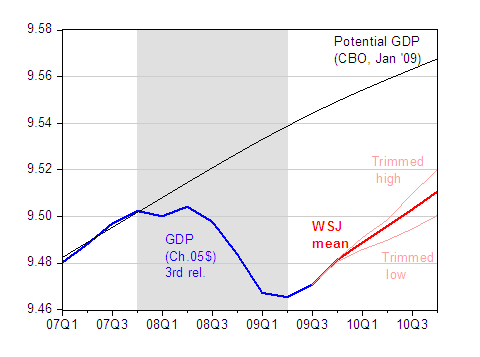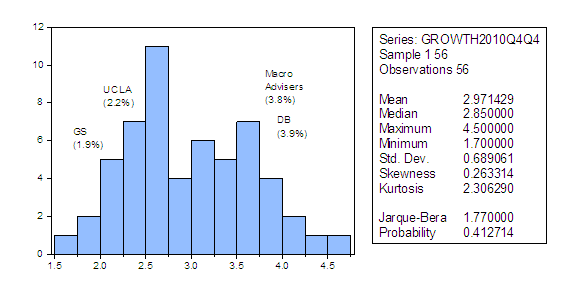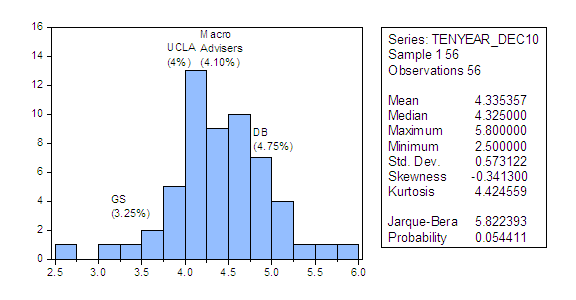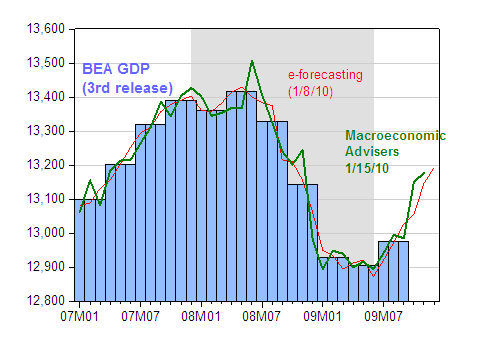The WSJ survey for January is out. Growth is predicted to be fairly rapid, but hardly torrid, in 2010, with q4/q4 mean estimate at 3.0%. Here’s the mean forecast of the log level of GDP, and the trimmed high and low forecasts.

Figure 1: Log GDP in Ch.2005$ (blue), mean WSJ forecast (red), and 20% trimmed high (pink) and trimmed low (pink) forecasts. Trimming removed the top 6 and bottom 6 forecasts out of 56 responses. NBER defined recession dates shaded gray, assuming recession end is 2009Q2. Potential GDP from CBO obtained by multiplying January 2009 estimate in Ch.2000$ by 1.14. Source: BEA 2009Q3 3rd release, WSJ January survey, CBO, NBER, and author’s calculations.
The 09Q3 gap of 7.3% (log terms) shrinks to 5.7% in 10Q4 according to the WSJ mean forecast. The (trimmed) high forecast implies a 4.8% gap, while the low forecast, a 6.7%.
One interesting aspect of the survey is the fact that the q4/q4 2010 forecasts are bimodal.

Figure 2: Histogram of 2010 q4/q4 growth. “GS” is Goldman Sachs/Hatzius; “UCLA” is UCLA/Leamer &Schulman; “Macro Advisers” is Macroeconomic Advisers/Prakken & Varvares; “DB” is Deutsche Bank/Lavorgne. Source: WSJ January survey.
What about worries about a collision of deficits and demand for Treasuries? The mean forecast is for a 10 year t-bill rate of 3.98% and 4.34% at end June and end December, 2010, respectively. The current ten year rate is 3.67.

Figure 3: Histogram of end-December 2010 ten year t-bill rates. “GS” is Goldman Sachs/Hatzius; “UCLA” is UCLA/Leamer &Schulman; “Macro Advisers” is Macroeconomic Advisers/Prakken & Varvares; “DB” is Deutsche Bank/Lavorgne. Source: WSJ January survey.
Finally, Macroeconomic Advisers released its estimates for December ’09 GDP.

Figure 4: Real GDP, 3rd release for ’09Q3, in billions of Ch.2005$ SAAR (blue bars), e-forecasting release of 8 January (red line), and Macroeconomic Advisers release of 14 January (green line). NBER defined recession dates shaded gray, assuming recession ends in 2009M06. Source: BEA, e-forecasting, Macroeconomic Advisers and NBER.
On a slightly different note, in terms of thinking whether output volatility will be substantially higher in the future, my coauthor Oli Coibion and his coauthor Yuriy Gorodnichenko have a VoxEU piece out which runs counter to the views of those who have declared the end of “The Great Moderation”.
It seems to me we’re still in a very unpredictable period, with a lot depending on the Fed’s decision on whether or not to extend purchases of mortgage-backed securities, and, by extension, the large-scale money creation which has characterized the US response to this recession. Markets are very uncertain, firstly about how the Fed will decide, and secondly about the possible results of the Fed’s possible choices. If MBS purchases end in March as tentatively planned, will the Fed let rates climb, or do something else to keep market rates as low as they are now? And if the latter, what? Reduce the interest rate paid on reserves? That seems very risky to me. It’s a tricky situation.
Menzie-
In my opinion, “The Great Moderation” in the USA was facilitated by the huge expansion of securitization, expansion of government spending, and decline of manufacturing; all as a fraction of GDP. Reduction in manufacturing results in less business cycle volatility, increased government spending provides uninterrupted cash flow, and increasing securitization provides the fig-leaf to delay actual payment to the indefinite future.
The saga continues with QE and impared asset purchases by the FED, US fiscal deficits in excess of 11%, and no action on derivative regulation. All these policies have one thing in common… they postpone settlement of current debts by increasing economic leverage on the backs of domestic businesses and households.
This policy of continual debt expansion will logically result in banking collapse and sovereign debt default. We are in the midst of the banking collapse, sovereign debt collapse may follow when and if multi-national corporations (MNCs) find a substitute for dollars in international trade.
The WSJ also reported on Friday that banks will pay $145 billion in bonuses for 2009. That’s a new record. If the $787 Billion stim program is spread over two years, then for comparison just bank bonuses along were almost half what the stim program was for the entire country!
Seems the trading desk was very profitable. Now we know what ZIRP and QE are good for.
Keep the faith on the economy getting better. Oh yes, then there will be the tax hike.
Cedric, do you know the right price of labor for banks? Evidence suggests that incentive compensation encourages and results in better outcomes. What about compensation of tech employees who get options repriced after the fact? Or auto workers who get buyouts and “job banks”? Or government workers with large, tax payer funded pensions. At least bankers can be fired… just try that with tenured faculty at state universities!
It seems to me we’re still in a very unpredictable period, with a lot depending on the Fed’s decision on whether or not to extend purchases of mortgage-backed securities, and, by extension, the large-scale money creation which has characterized the US response to this recession. Markets are very uncertain, firstly about how the Fed will decide, and secondly about the possible results of the Fed’s possible choices. If MBS purchases end in March as tentatively planned, will the Fed let rates climb, or do something else to keep market rates as low as they are now? And if the latter, what? Reduce the interest rate paid on reserves? That seems very risky to me. It’s a tricky situation.
Soon or later States borrowings and debts will be in an impasse. As of today there is a perpetual motion between CBs, States public debts and domestic banks accomplishing their citizen duties, that is the purchases of governments debts.
The derivatives in the Interest rates swaps, the primary dealers hoarding of government issues, the banks use of cash money are making wonder.
Several cases are worth studying:
Greece may offer an in vitro test case (too small for not to fail).
The CBs balance sheet expansion may continue, but external debt and domestic debt (P34 may offer easy guidance for corelation purpose),inflation,commodity prices (P33) will direct the debts prices (domestic and external).
Please see the correlations between debts default,inflation,commodities prices,sudden capital inflows and outflows, leading to banking crisis (fig 4 P11). Few months ago the cumulative external debts of USA/ UK was representing 50 % of the world GDP (has it changed by that much?)
This Time is Different: A Panoramic View of Eight Centuries of
Financial Crises*
Carmen M. Reinhart, University of Maryland and NBER
Kenneth S. Rogoff, Harvard University and NBE
On a micro standpoint Banks are exhibiting through their balance sheets the same symptoms of any countries when in crisis, that is their bonds portfolio is larger than the loans portfolio. (neglecting the regulatory aspect of capital to assets ratios), the same goes for the IRS derivatives.
From Anonymous above, with reference to bonuses for Wall Street:
“Evidence suggests that incentive compensation encourages and results in better outcomes.”
HAHAHAHAHAHA!!!
Yes, incentive compensation does work when you actually measure success correctly. If you measure success of long term products with short term measures you’re bound to create situations like we just experienced. “Quick, sell as many mortgages as we can! I want to buy another house this year!”
Give the bankers a bonus of restricted stock grants that vest over 10 or 20 years and then we’ll be more likely to see employees that give a damn about the health of their company (and the economy as a consequence) in the future.
The 3.0% growth forecast for 2010 q4/q4 is far too low. Extremely expansionary monetary and fiscal policies will bring a strong recovery. The roller-coaster economy goes on.
Mr Coibion’s statistical games don’t put bread on the table of the many households suffering from unemployment and under-employment. Clever damped measures of volatility are irrelevant to the economic performance that matters. This piece suggests one more area where we have excess capacity: math geeks on economics tenure tracks.